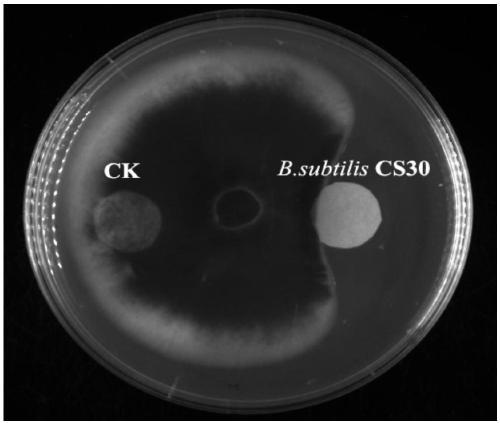Bacillus subtilis CS30 and application thereof
A technology of Bacillus subtilis and Bacillus marine, applied in application, bacteria, fungicides and other directions, can solve problems such as environmental pollution and food safety, and achieve the effect of improving food and food safety.
- Summary
- Abstract
- Description
- Claims
- Application Information
AI Technical Summary
Problems solved by technology
Method used
Image
Examples
Embodiment 1
[0040] Bacillus subtilis CS30 was isolated from deep-sea cold seep sediments in my country. The 16S rDNA sequence of the marine bacterium Bacillus subtilis CS30 is shown in SEQ ID NO.1. After the strain was grown on LB solid medium for 2 days, the colonies appeared milky white, the edges of the colonies were irregular in shape, and many irregular folds appeared on the surface.
[0041] The 16S rDNA (SEQ ID NO.1) sequence of the Bacillus subtilis CS30 is:
[0042] CCTTCGGCGGCTGGCTCCTAAAGGTTACCTCACCGACTTCGGGTGTTAAA ACTCTCGTGGTGTGACGGGCGGTGTGTACAAGGCCCGGGAACGTATTCAC CGCGGCATGCTGATCCGCGATTACTAGCGATTCCAGCTTCACGCAGTCGA GTTGCAGACTGCGATCCGAACTGAGAACAGATTTGTGGGATTGGCTTAAC CTCGCGGTTTCGCTGCCCTTTGTTCTGTCCATTGTAGCACGTGTGTAGCC CAGGTCATAAGGGGCATGATGATTTGACGTCATCCCCACCTTCCTCCGGT TTGTCACCGGCAGTCACCTTAGAGTGCCCAACTGAATGCTGGCAACTAAG ATCAAGGGTTGCGCTCGTTGCGGGACTTAACCCAACATCTCACGACACGA GCTGACGACAACCATGCACCACCTGTCACTCTGCCCCCGAAGGGGACGTC CTATCTCTAGGATTGTCAGAGGATGTCAAGACCTGGTAAGGTTCTTCGCG TTGCTTCGAATTAA...
Embodiment 2
[0044] Example 2 Inhibition of Bacillus subtilis CS30 on Magnaporthe grisea and Gibberella zea.
[0045] The rice blast fungus was inoculated on the potato dextrose solid medium (PDA) and cultured at 28°C for 2-5 days, and then the fermentation broth obtained from the fermentation culture of the bacillus Bacillus subtilis CS30 was filtered through a filter membrane and dropped on the On the sterilized small filter paper sheet, the filter paper sheet is air-dried and placed at a place 2cm away from the blast fungus bacterium block. Culture at 28°C for 3-5 days. After the cultivation, it was observed that the growth of rice blast fungus was significantly inhibited on the culture medium on the side where the Bacillus subtilis CS30 fermentation broth was added dropwise, while the culture medium without the addition of the Bacillus subtilis CS30 fermentation broth was significantly inhibited. Magnaporthe grisea grew well on one side and was not inhibited ( figure 1 ). The experi...
Embodiment 3
[0046] Example 3 Fermentation, separation and identification of active substances produced by Bacillus subtilis CS30.
[0047] The bacterial strain in Example 1 was fermented and cultivated for 48 hours at 28°C, 160rpm liquid medium (peptone 10g / L, yeast powder 5g / L, sodium chloride 10g / L, distilled water 1L, pH 7.0), after fermentation, centrifuged at 8000rpm 15 minutes, collect the fermentation supernatant, adjust the pH of the supernatant to 2.0 with hydrochloric acid, and then overnight at 4°C, collect the acidified precipitated product, extract with methanol, and perform rotary vacuum evaporation on the obtained extracted product to obtain subtilis Crude extract of Bacillus subtilis CS30 active substance.
[0048] The crude extract was further separated and purified by silica gel column chromatography and high performance liquid chromatography (HPLC, UV 210nm). Active substance fractions were obtained by HPLC separation, HPLC used Agilent 1260 series, the mobile phase wa...
PUM
 Login to View More
Login to View More Abstract
Description
Claims
Application Information
 Login to View More
Login to View More - R&D
- Intellectual Property
- Life Sciences
- Materials
- Tech Scout
- Unparalleled Data Quality
- Higher Quality Content
- 60% Fewer Hallucinations
Browse by: Latest US Patents, China's latest patents, Technical Efficacy Thesaurus, Application Domain, Technology Topic, Popular Technical Reports.
© 2025 PatSnap. All rights reserved.Legal|Privacy policy|Modern Slavery Act Transparency Statement|Sitemap|About US| Contact US: help@patsnap.com



